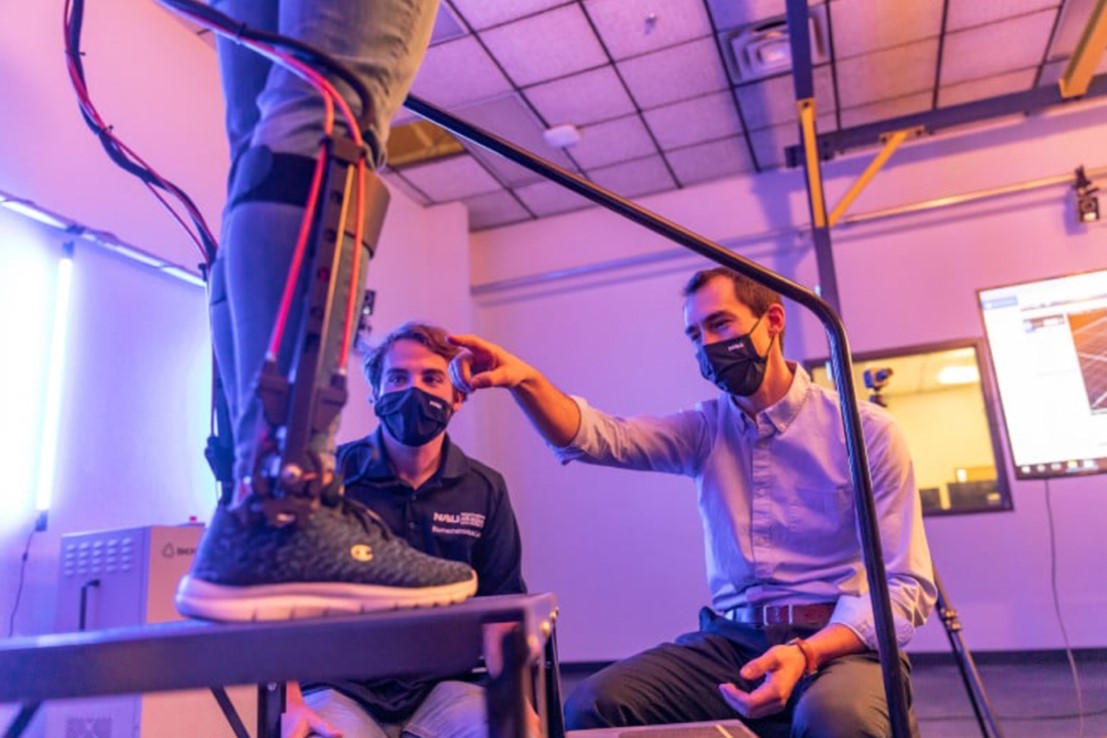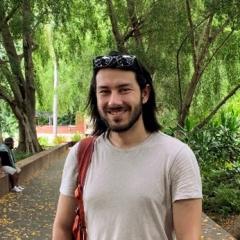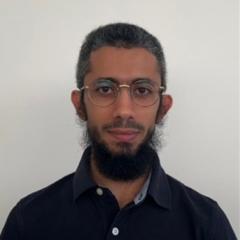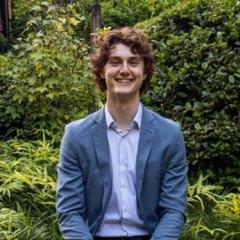Welcome to the Neuromuscular Biomechanics Lab at UQ.
The overarching goal of our research is to understand the neuromuscular and biomechanical mechanisms that underpin healthy and pathological locomotor function. Our work is at the cutting edge of biomechanics, developing novel imaging methods and modelling frameworks to answer fundamental questions about how movement underpins evolution, health, and disease, with findings that have application across a range of disciplines.
Our main research themes
Combining in vivo and in silico tools
We are working to unravel the mechanisms of muscle-tendon function using a combination of experiments and computational models and simulations
Links between form and function
We are exploring how musculoskeletal anatomy, neural control, and biomechanics integrate and adapt to challenges such as size, age, and disease
Bio-inspiration for technology
We are designing and applying wearable assistive devices (ie: exoskeletons) to augment healthy or restore pathological movement. We are particularly interested in how devices interact with tissues of the musculoskeletal system
If you are interested in collaborating or joining our research team, please don't hesitate to reach out to our Group Leader, Dr Taylor Dick t.dick@uq.edu.au.
Group Head
Research staff
Postdoctoral fellows
PhD students
Honours students
UQ collaborators
- Associate Professor Kylie Tucker, Motor control and pain research Laboratory, University of Queensland
- Associate Professor Frederik Steyn, Heterogeneity in Neurodegenerative Disease Research Group, University of Queensland
- Associate Professor Shyuan Ngo, Australian Institute for Bioengineering and Nanotechnology, University of Queensland
- Dr Manuela Besomi Research Fellow, School of Health and Rehabilitation Sciences
External collaborators
- Associate Professor Christofer Clemente, Biomechanics and Biorobotics lab, University of the Sunshine Coast, Sippy Downs, Australia
- Professor Glen Lichtwark, School of Exercise & Nutrition Sciences, Queensland University of Technology
- Professor Francois Hug, Laboratoire Motricité Humaine, Education, Sport, Santé, Université Côte d'Azur
- Professor Monica Daley, Neuromechanics Laboratory, University of California
- Professor Gregory Sawicki, Power lab, Georgia Tech
- Associate Professor Zachary Lerner, Biomechatronic Laboratory, Northern Arizona University
- Dr Dominic Farris, Neuromuscular Biomechanics, University of Exeter
- Dr Jessica Bugeja , Neurodevelopment and Plasticity team, CSIRO’s Australian eHealth Research Centre
Alumni
Name | Degree | Year |
|---|---|---|
Ben Kelley | Honours | 2024 |
Nikki Kelp | PhD | 2023 |
James Williamson | PhD | 2023 |
Raphael Hamard | PhD | 2023 |
India Lindemann | Honours | 2023 |
Connor Clarke | Honours | 2021 |
Sabrina Pinel | Masters | 2020 |
Romain Feigean | Masters | 2020 |
Undergraduate Researchers and Summer/Winter Scholars
- India Lindemann – Undergraduate Student (Mathematics)
- Matt Richards – Undergraduate Student (Physics)
- Jordan Yee – Undergraduate Student (Engineering)
- Anna Gore – Undergraduate Student (Human Movement and Nutrition Sciences)
Capabilities
Our lab aims to understand the neural and musculoskeletal mechanisms that underpin movement, and how wearable assistive technologies can be optimised to provide maximum benefit to end users. We use a highly integrative approach that combines novel experimental tools with computer modelling and simulation techniques.
The neuromuscular biomechanics laboratory features a dedicated research space. This space houses state-of-the-art data collection equipment from Bertec Corp. (Instrumented Treadmill), Qualisys AB. and NaturalPoint Inc. (Motion Capture System), Delsys Inc. (Electromyography System), and Telmed AB. (B-mode Ultrasound). This powerful suite of equipment, in addition to custom and opensource (OpenSim) analysis pipelines uniquely places the neuromuscular biomechanics laboratory to run experiments which investigate the multi-scale measures of locomotor performance:
- Discover fundamental mechanisms between the form and function of the neuro-musculoskeletal system, in both health and disease.
- Inform the optimal design of wearable assistive technologies (exoskeletons and prosthetics) capable of augmenting or restoring mobility.
- Assess the influence of targeted interventions (exercise or technology based).
View a full list of publications on eSpace
Current projects
 Improving MObility Via Exoskeletons in people living with Motor Neurone Disease (MND) [iMOVE-MND]
Improving MObility Via Exoskeletons in people living with Motor Neurone Disease (MND) [iMOVE-MND]
MND is a progressive neurodegenerative disease characterized by muscle weakness and loss of voluntary motor control, leading to mobility impairment and diminished independence. Participants adopt compensatory gait strategies, including hip hiking and foot drag, which results in slow, asymmetrical, and inefficient gait. While not yet assessed in MND, this contributes to movement decline in other neurological disorders. To address these challenges, we are currently assessing, adapting, and implementing novel wearable robotic devices which aim to enhance movement.
Investigative team: James Williamson, Robert Henderson, Zachary F. Lerner, Frederik Steyn, Shyuan Ngo and Taylor Dick.
Exploring the influence of a 12-week ankle exoskeleton intervention on walking performance and muscle-tendon architecture in children with Cerebral Palsy
Robotic ankle exoskeletons have previously been shown to improve walking performance in children with CP after brief interventions (1-4 weeks). However, we have limited information regarding the underlying adaptations these devices are causing in the user’s muscle architecture. This study will explore the influence of a 12-week ankle exoskeleton intervention on walking performance and the feasibility of that intervention in children with cerebral palsy.
Investigative team: Angus Cottrell, Teresa Phillips, Chris Carty, Dana Bradford James Williamson, Jess Bugeja, Taylor Dick.
Exploring the influence of passive ankle exoskeletons on the neuromechanics of balance in younger and older adults
Assistive wearable devices are designed to restore or augment the user’s physical abilities. Our research explores the influence of biologically inspired ankle exoskeletons on balance and gait in healthy and clinical populations. Passive, lower limb exoskeletons have shown to reduce the physiological demands of motion, but their influence on underlying neuromuscular behaviour remains largely unknown.
Investigative team: Jemima Po, James Williamson, Dominic Farris, Taylor Dick.
Investigating the energetics of muscle contraction
The way we activate our muscles has the potential to alter the amount of energy required to produce a given force. Through the combination of high-density electromyography, indirect calorimetry, and mathematical models of muscle recruitment patterns, we aim to make better predictions of muscle energy use during daily movements.
Investigative team: Ryan Konno, Glen Lichtwark, Taylor Dick.
Non-invasive estimates of neuromuscular properties using ultra-wideband radar
Accurately measuring the forces produced by skeletal muscle has application across several scientific fields. However, current methods to do so 1) become inaccurate when muscle fatigues, 2) are incompatible with certain rehabilitation technologies such as functional electrical stimulation (FES), or 3) are impractical to use outside of laboratory environments. This project proposes the development, evaluation, and application of ultra-wideband (UWB) radar as a novel technology to indirectly estimate muscle force output, with estimates of muscle force based on changes in the electromagnetic properties of muscle during contraction.
Investigative team: Chris Bird, Antonio Padilha Lanari Bo, Wei Lu, and Taylor Dick.
Untangling the unique energetic capabilities of kangaroos and their relatives
This project focuses on the unique energetic capabilities of kangaroos and their relatives. We are building OpenSim musculoskeletal model of and their relatives to investigate how these animals move to, for example, mitigate the metabolic cost of hopping with a joey. Outcomes from this work may provide biological inspiration for the design of wearable assistive technologies.
Investigative team: Lauren Thornton, Miyuki Chamberlain, Taylor Dick, A/Prof Christofer Clemente
Integrating experiments and musculoskeletal simulations to explore non-steady locomotion across scales
Animals rarely move in steady environments – they are constantly speeding up or slowing down, turning, and encountering obstacles. Much of our current understanding of animal locomotion is derived from the study of steady-state, cyclical movements, leaving a gap in our understanding of real-world animal locomotion. This project aims to develop a musculoskeletal simulation framework capable of predicting nonsteady movement patterns and to use this model to test theories about how animals (both big and small) are able to achieve robust locomotion in more complex, real-world environments.
Investigative team: India Lindemann, Christofer Clemente, Friedl De Groote, Taylor Dick
We believe in the power of collaboration to drive innovation. Our industry partners include:
Dr Taylor Dick has been recognised for her innovation in anatomy and biomedical sciences courses through the development of interactive teaching resources.
- 2021, UQ Teaching Excellence Award:
- 2021, 2021, Nominated for the Faculty of Medicine Rising Star of the Year Award
If you are an undergraduate student, consider taking BIOM3003 to get an overview of what we do!
If you’re interested in scheduling a lab tour or discussing outreach events and activities, feel free to reach out to us. We’d be happy to connect with you!
Some events we are inolved in:
We are located on the St Lucia Campus of the University of Queensland. The Gait Lab facility is hosted on the 3rd floor of building 81.
Joining the lab
PhD Students
If you are interested in learning more about our lab and programs at UQ, feel free to reach out to our group leader Dr Taylor Dick (t.dick@uq.edu.au) or one of our wonderful graduate students.
Learn more about Higher Degrees by Research
Honours/undergraduate summer and winter research students
We encourage you to look through our lab’s current projects. If you are interested in conducting research with us, contact our group leader Dr Taylor Dick (t.dick@uq.edu.au).
For information regarding project requirements and application guidelines see the following links:
Find out more about our diverse range of research interests.















